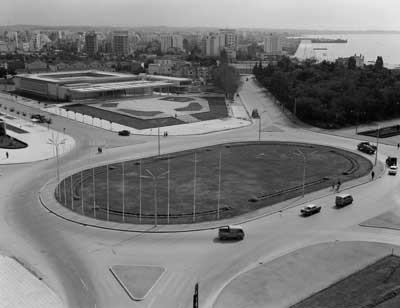
Η έκθεση εγκαινιάστηκε τον Μάϊο του 2013 στο Μακεδονικό Μουσείο Σύγχρονης Τέχνης Θεσσαλονίκης σε συνεργασία με το Μουσείο Μπενάκη της Αθήνας.
 Η Θεσσαλονίκη στα 2.300+ χρόνια της επίσημης ιστορίας της (δεν υπολογίζονται οι προϊστορικοί οικισμοί και η Θέρμη που προυπήρξαν) αποτέλεσε την "Πύλη" της Βαλκανικής ενδοχώρας προς /από τον υπόλοιπο Μεσογειακό κόσμο και σαν σημαντική "Πύλη" που ήταν (και συνεχίζει να είναι) επέπρωτο να περάσουν από αυτή σχεδόν όλοι οι λαοί της Μεσογείου και της Ευρωπαϊκής ενδοχώρας -και όχι μόνο. Το αέναο αυτό πέρασμα ανθρώπων και πολιτισμών είχε σαν αποτέλεσμα τις συνεχείς αλλαγές στο πρόσωπο της πόλης. Τα εκατό τελευταία χρόνια η Θεσσαλονίκη άλλαξε δραματικά με τέτοια ταχύτητα, όπως ίσως ποτέ πριν στην συνεχή ιστορία της δεν είχε συμβεί -ίσως δε και σε καμμία άλλη Ευρωπάϊκή πολή (πλήν Κωνσταντινούπολης).
Η Θεσσαλονίκη στα 2.300+ χρόνια της επίσημης ιστορίας της (δεν υπολογίζονται οι προϊστορικοί οικισμοί και η Θέρμη που προυπήρξαν) αποτέλεσε την "Πύλη" της Βαλκανικής ενδοχώρας προς /από τον υπόλοιπο Μεσογειακό κόσμο και σαν σημαντική "Πύλη" που ήταν (και συνεχίζει να είναι) επέπρωτο να περάσουν από αυτή σχεδόν όλοι οι λαοί της Μεσογείου και της Ευρωπαϊκής ενδοχώρας -και όχι μόνο. Το αέναο αυτό πέρασμα ανθρώπων και πολιτισμών είχε σαν αποτέλεσμα τις συνεχείς αλλαγές στο πρόσωπο της πόλης. Τα εκατό τελευταία χρόνια η Θεσσαλονίκη άλλαξε δραματικά με τέτοια ταχύτητα, όπως ίσως ποτέ πριν στην συνεχή ιστορία της δεν είχε συμβεί -ίσως δε και σε καμμία άλλη Ευρωπάϊκή πολή (πλήν Κωνσταντινούπολης).
Οθωμανικός εκλεκτικισμός, Βαλκανικοί Πόλεμοι, Αγγλογάλλοι της Entente, πυρκαγιά του  '17, πρόσφυγες του '22, ανοικοδόμηση του '30, πόλεμος και κατοχή, αντιπαροχή, νέα δημόσια κτίρια από το '60 και μετά, επιχωμάτωση και επέκταση Νέας Παραλίας, νεοελληνικές γραφειοκρατικές αγκυλώσεις και χρονίζοντα δημόσια έργα κοινής ωφέλειας...
'17, πρόσφυγες του '22, ανοικοδόμηση του '30, πόλεμος και κατοχή, αντιπαροχή, νέα δημόσια κτίρια από το '60 και μετά, επιχωμάτωση και επέκταση Νέας Παραλίας, νεοελληνικές γραφειοκρατικές αγκυλώσεις και χρονίζοντα δημόσια έργα κοινής ωφέλειας...
 '17, πρόσφυγες του '22, ανοικοδόμηση του '30, πόλεμος και κατοχή, αντιπαροχή, νέα δημόσια κτίρια από το '60 και μετά, επιχωμάτωση και επέκταση Νέας Παραλίας, νεοελληνικές γραφειοκρατικές αγκυλώσεις και χρονίζοντα δημόσια έργα κοινής ωφέλειας...
'17, πρόσφυγες του '22, ανοικοδόμηση του '30, πόλεμος και κατοχή, αντιπαροχή, νέα δημόσια κτίρια από το '60 και μετά, επιχωμάτωση και επέκταση Νέας Παραλίας, νεοελληνικές γραφειοκρατικές αγκυλώσεις και χρονίζοντα δημόσια έργα κοινής ωφέλειας...
την αξία κτιρίων από τα οποία άλλα στέκουν ακόμα στο αστικό τοπίο της Θεσσαλονίκης και άλλα δεν υπάρχουν πια. Σαν τον Αμερικανό επισκέπτη που αναφώνησε με έκπληξη "I never thought that it was so important!" αναφερόμενος στο παλιό Αμερικανικό προξενείο στην Παλιά Παραλία όταν είδε τη σχετική φωτογραφία στην έκθεση! Πολλά συγχαρητήρια στους διοργανωτές και στην University Studio Press για την επιμελημένη έκδοση.
13. Thessaloniki 1912-2012 The Architecture of a Century
The exhibition opened in May 2013 in the Macedonian Museum of Contemporary Art in cooperation with the Benaki Museum of Athens.
Thessaloniki during the 2.300+ years of its official history (without counting in the prehistoric settlements and Thermi that pre-existed in the area) was the "Gateway" of the Balkan inland to/ from the rest of the Mediterranean world and as that important a "Gateway", was destined to be the passage of almost all the peoples of the Mediterranean and the European inland -and not only! This perennial, physical-almost, process of
peoples and cultures passing through it, is the reason for the continuous transformation of the city. The last hundred years in particular, Thessaloniki changed dramatically and at such a speed like never before in its history - maybe like no other European city (except Istanbul) ever did.
peoples and cultures passing through it, is the reason for the continuous transformation of the city. The last hundred years in particular, Thessaloniki changed dramatically and at such a speed like never before in its history - maybe like no other European city (except Istanbul) ever did.
Ottoman architectural eclectisism, the Balkan Wars, Entente, the fire of '17, the influx of refugees of '22, the re-organization of the '30s, the WWII and the German occupation, "antiparoche" (Greek word that can hardly be translated efficiently but can only be described, meaning: a common practice that started in the '50s- when construction was decided to be the locomotive of the Greek economy - with the owner of a property agreeing with a contractor to offer his property -a plot with or without a house in- for the construction of a new block of appartments and take a couple of new appartments in return when the construction was over), the new public buildings from the '60s and on, the expansion of the seafront towards the sea in the eastern side of the city, the neo-greek bureaucracy malfunctions and interminably incomplete public works aimed for the common benefit...
All these can be traceable in present-time Thessaloniki like the grooves in the revolver handle and in combination with the older Roman and Byzantine monuments compose the face of the city today. Thessaloniki could be considered as an immense museum dedicated to Architecture (Hébrard, Poselli, Karantinos, Valentis, Nikopoulos, Doxiadis, Milonas, Krokos are but a few of the architects presented in the exhibition) despite the fact that many important buildings have been demolished courtesy of the profitable "antiparoche"...



No comments:
Post a Comment